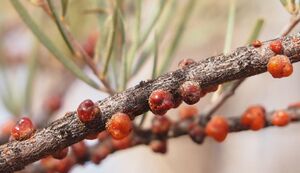Biology:Lerp
From HandWiki
Short description: Structure of crystallized honeydew

In biology, a lerp is a structure of crystallized honeydew produced by larvae of psyllid bugs as a protective cover. These animals are commonly referred to as lerp insects, of which there are over 300 species in Australia.[1]
Lerps are energy rich, consisting mostly of starch, with some proteins and fats.[1] They are eaten by flying foxes, possums and birds such as pardalotes and honeyeaters.[1]
The word is derived from the Wemba Wemba word lerep.[2] Lerps are traditionally eaten by Indigenous people, and can be stored as dry balls for future use.[3]
External links
- University of California Integrated Pest Management
- University of California Center for Biological Control
- Lerp Psyllid resources provided by Pacific Coast Arborists and Consultants
References
- ↑ 1.0 1.1 1.2 "Lerps - One of nature's sweet offerings" (in en-AU). 2019-08-07. https://www.lfwseq.org.au/lerps-one-of-natures-sweet-offerings/.
- ↑ Australian Aboriginal Words in English. Melbourne: Oxford University Press. 2006. p. 103. ISBN 9780195540734.
- ↑ Faast, Renate; Clarke, Philip A.; Taylor, Gary S.; Salagaras, Renée L.; Weinstein, Philip (2020-09-01). "Indigenous Use of Lerps in Australia: So Much More Than a Sweet Treat". Journal of Ethnobiology 40 (3): 328–347. doi:10.2993/0278-0771-40.3.328. ISSN 0278-0771. https://bioone.org/journals/journal-of-ethnobiology/volume-40/issue-3/0278-0771-40.3.328/Indigenous-Use-of-Lerps-in-Australia--So-Much-More/10.2993/0278-0771-40.3.328.full.
- "New Agricultural Pest for Southern California Redgum Lerp Psyllid". California Plant Pest and Disease Report (Department of Food and Agriculture, Division of Plant Industry) 17 (1–3): 7. 1998. ISSN 1947-0657. https://www.cdfa.ca.gov/plant/ppd/PDF/CPPDR_1998_17_1-3.pdf.
- Dobson, T. (1857). "On Laap, or Lerp, the Cup-Like Coverings of Psyllidae Found on the Leaves of Certain Eucalypti". Transactions of the Microscopical Society & Journal 5: 123–130. doi:10.1111/j.1365-2818.1857.tb02049.x.
- Paton, D.C. (1980). "The Importance of Manna, Honeydew and Lerp in the Diets of Honeyeaters". Emu 80 (4): 213–226. doi:10.1080/01584197.1980.11799277.
- Woinarski, J.C.Z. (1984). "Small Birds, Lerp-Feeding and the Problem of Honeyeaters". Emu - Austral Ornithology 84 (3): 137–141. doi:10.1071/MU9840137.
- Ernst, W.H.O.; Sekhwela, M.B.M. (1987). "The chemical composition of lerps from the mopane psyllid Arytaina mopane (Homoptera, Psyllidae)". Insect Biochemistry 17 (6): 905–9. doi:10.1016/0020-1790(87)90027-8.
- Faast, R.; Clarke, P.A.; Taylor, G.S.; Salagaras, R.L.; Weinstein, P. (24 September 2020). "Indigenous Use of Lerps in Australia: So Much More Than a Sweet Treat". Journal of Ethnobiology 40 (3): 328–347. doi:10.2993/0278-0771-40.3.328.
- Hollis, D. (2004). Australian Psylloidea: Jumping Plantlice and Lerp Insects. Australian Biological Resources Study. ISBN 9780642568366.
- Sharma, Anamika (December 2014). Bionomics and nutritional ecology of three species of Aphalaridae (Psylloidea) of varied guilds in Australia feeding on different species of Eucalyptus (Myrtaceae) in central-western New South Wales (PhD). Charles Sturt University. pp. 74, 77.
